Analysis of Leadership, Management, and Performance at TESCO
VerifiedAdded on 2023/02/02
|15
|4270
|69
Report
AI Summary
This report provides a comprehensive analysis of leadership, management, and decision-making within TESCO, a multinational retailer. It explores the importance of defining the scope, objectives, and success criteria of decisions, along with the impact analysis and the value of valid information. The report differentiates between the influence of leaders and managers, examines sustainable leadership styles, and delves into motivational theories such as Maslow's hierarchy of needs. It also outlines the responsibilities of a manager in planning, coordinating, and controlling work, and how managers ensure objective achievement. Furthermore, it discusses performance management, performance measures, key performance indicators (KPIs), and the use of management accounts and information systems. The report concludes with a discussion on the distinctions between outcomes and outputs, providing valuable insights into TESCO's business operations and management strategies.
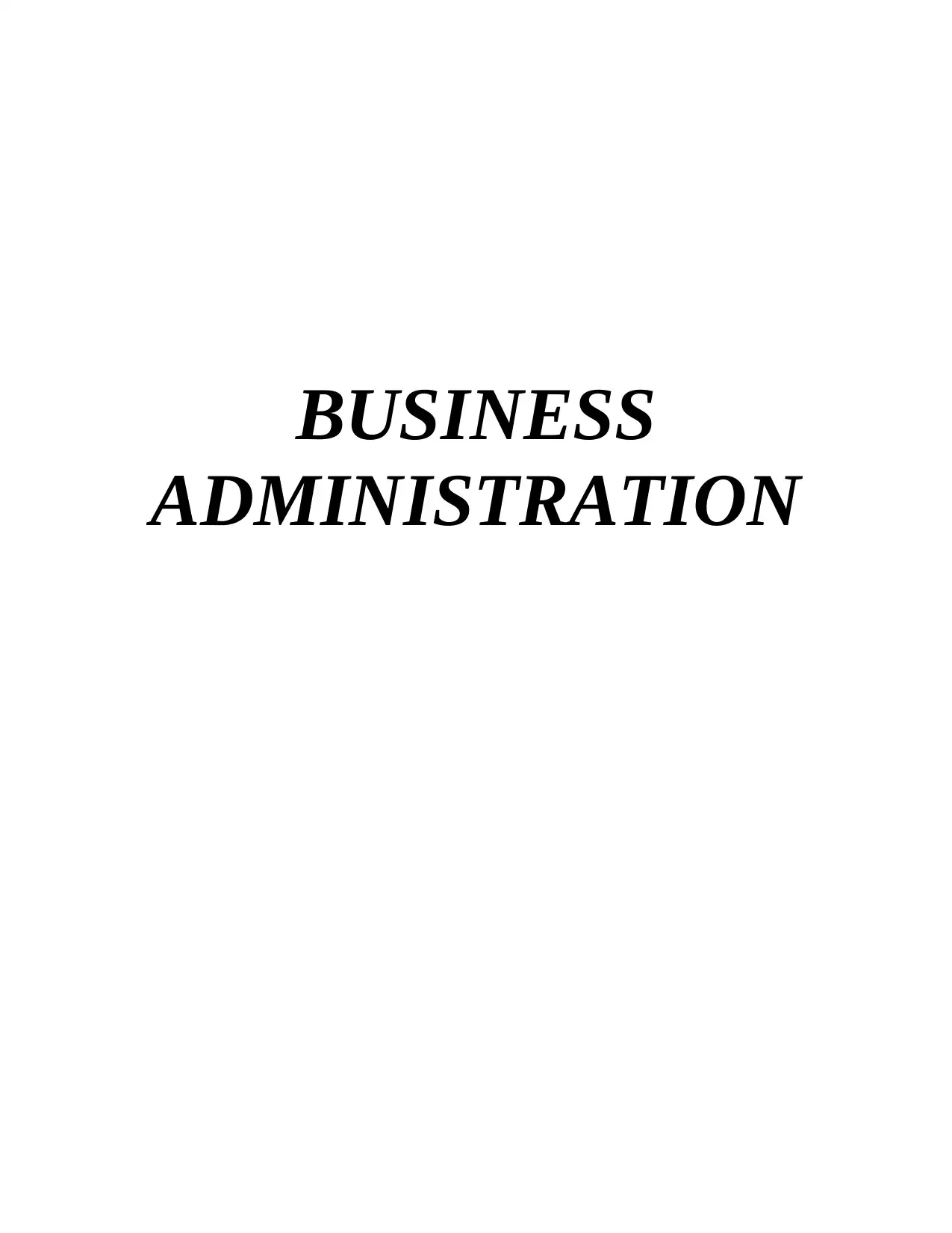
BUSINESS
ADMINISTRATION
ADMINISTRATION
Paraphrase This Document
Need a fresh take? Get an instant paraphrase of this document with our AI Paraphraser
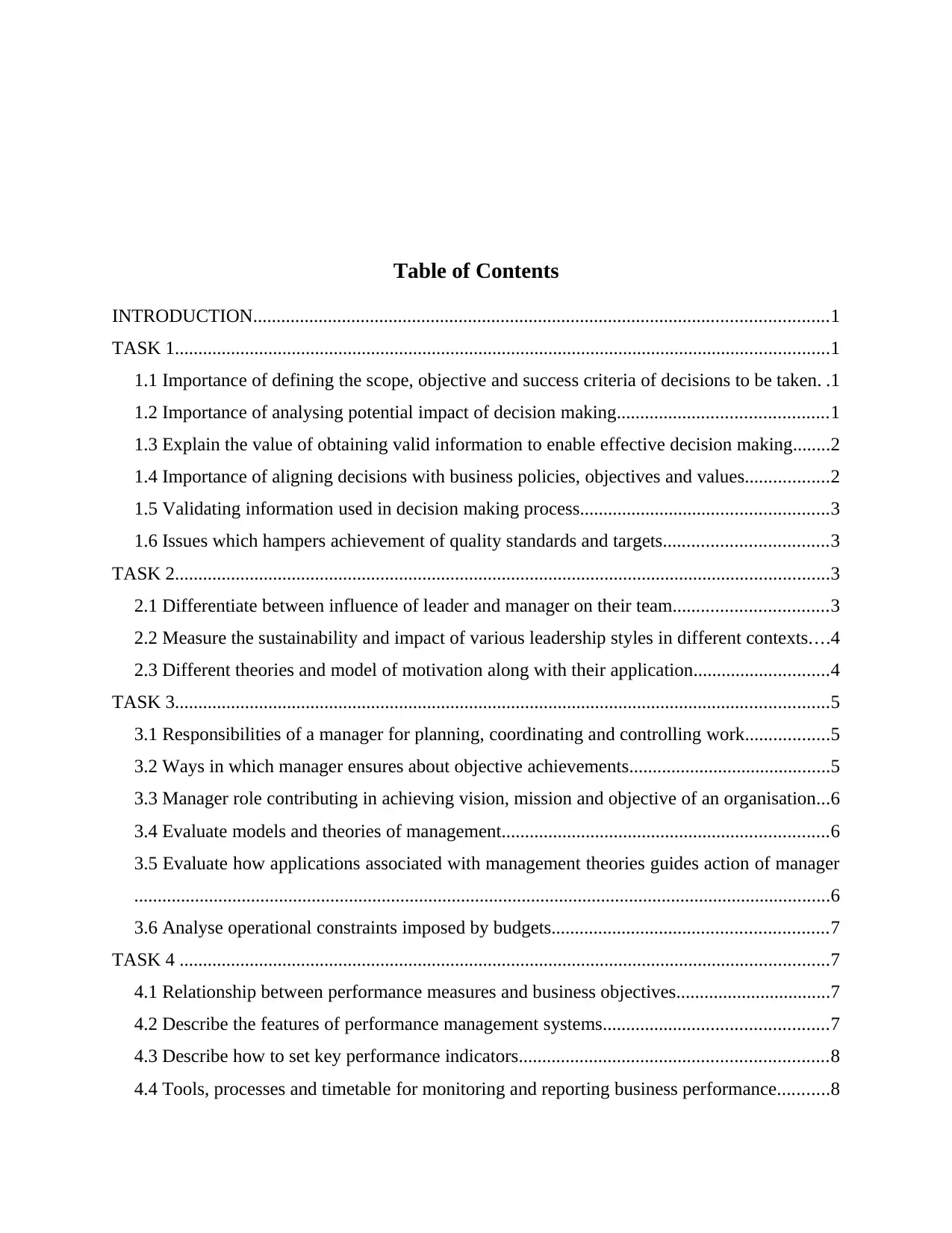
Table of Contents
INTRODUCTION...........................................................................................................................1
TASK 1............................................................................................................................................1
1.1 Importance of defining the scope, objective and success criteria of decisions to be taken. .1
1.2 Importance of analysing potential impact of decision making.............................................1
1.3 Explain the value of obtaining valid information to enable effective decision making........2
1.4 Importance of aligning decisions with business policies, objectives and values..................2
1.5 Validating information used in decision making process.....................................................3
1.6 Issues which hampers achievement of quality standards and targets...................................3
TASK 2............................................................................................................................................3
2.1 Differentiate between influence of leader and manager on their team.................................3
2.2 Measure the sustainability and impact of various leadership styles in different contexts....4
2.3 Different theories and model of motivation along with their application.............................4
TASK 3............................................................................................................................................5
3.1 Responsibilities of a manager for planning, coordinating and controlling work..................5
3.2 Ways in which manager ensures about objective achievements...........................................5
3.3 Manager role contributing in achieving vision, mission and objective of an organisation...6
3.4 Evaluate models and theories of management......................................................................6
3.5 Evaluate how applications associated with management theories guides action of manager
.....................................................................................................................................................6
3.6 Analyse operational constraints imposed by budgets...........................................................7
TASK 4 ...........................................................................................................................................7
4.1 Relationship between performance measures and business objectives.................................7
4.2 Describe the features of performance management systems................................................7
4.3 Describe how to set key performance indicators..................................................................8
4.4 Tools, processes and timetable for monitoring and reporting business performance...........8
INTRODUCTION...........................................................................................................................1
TASK 1............................................................................................................................................1
1.1 Importance of defining the scope, objective and success criteria of decisions to be taken. .1
1.2 Importance of analysing potential impact of decision making.............................................1
1.3 Explain the value of obtaining valid information to enable effective decision making........2
1.4 Importance of aligning decisions with business policies, objectives and values..................2
1.5 Validating information used in decision making process.....................................................3
1.6 Issues which hampers achievement of quality standards and targets...................................3
TASK 2............................................................................................................................................3
2.1 Differentiate between influence of leader and manager on their team.................................3
2.2 Measure the sustainability and impact of various leadership styles in different contexts....4
2.3 Different theories and model of motivation along with their application.............................4
TASK 3............................................................................................................................................5
3.1 Responsibilities of a manager for planning, coordinating and controlling work..................5
3.2 Ways in which manager ensures about objective achievements...........................................5
3.3 Manager role contributing in achieving vision, mission and objective of an organisation...6
3.4 Evaluate models and theories of management......................................................................6
3.5 Evaluate how applications associated with management theories guides action of manager
.....................................................................................................................................................6
3.6 Analyse operational constraints imposed by budgets...........................................................7
TASK 4 ...........................................................................................................................................7
4.1 Relationship between performance measures and business objectives.................................7
4.2 Describe the features of performance management systems................................................7
4.3 Describe how to set key performance indicators..................................................................8
4.4 Tools, processes and timetable for monitoring and reporting business performance...........8
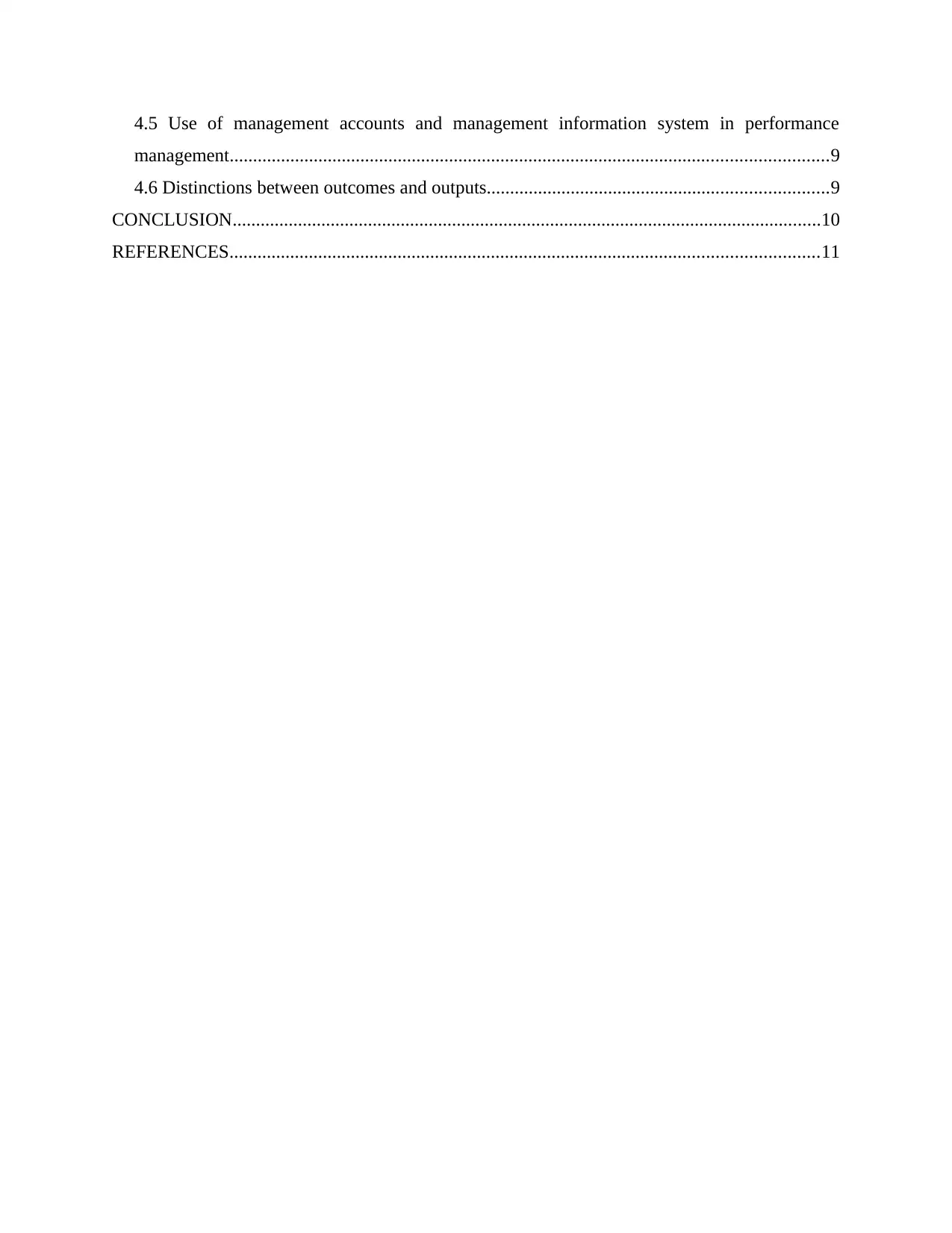
4.5 Use of management accounts and management information system in performance
management................................................................................................................................9
4.6 Distinctions between outcomes and outputs.........................................................................9
CONCLUSION..............................................................................................................................10
REFERENCES..............................................................................................................................11
management................................................................................................................................9
4.6 Distinctions between outcomes and outputs.........................................................................9
CONCLUSION..............................................................................................................................10
REFERENCES..............................................................................................................................11
⊘ This is a preview!⊘
Do you want full access?
Subscribe today to unlock all pages.

Trusted by 1+ million students worldwide
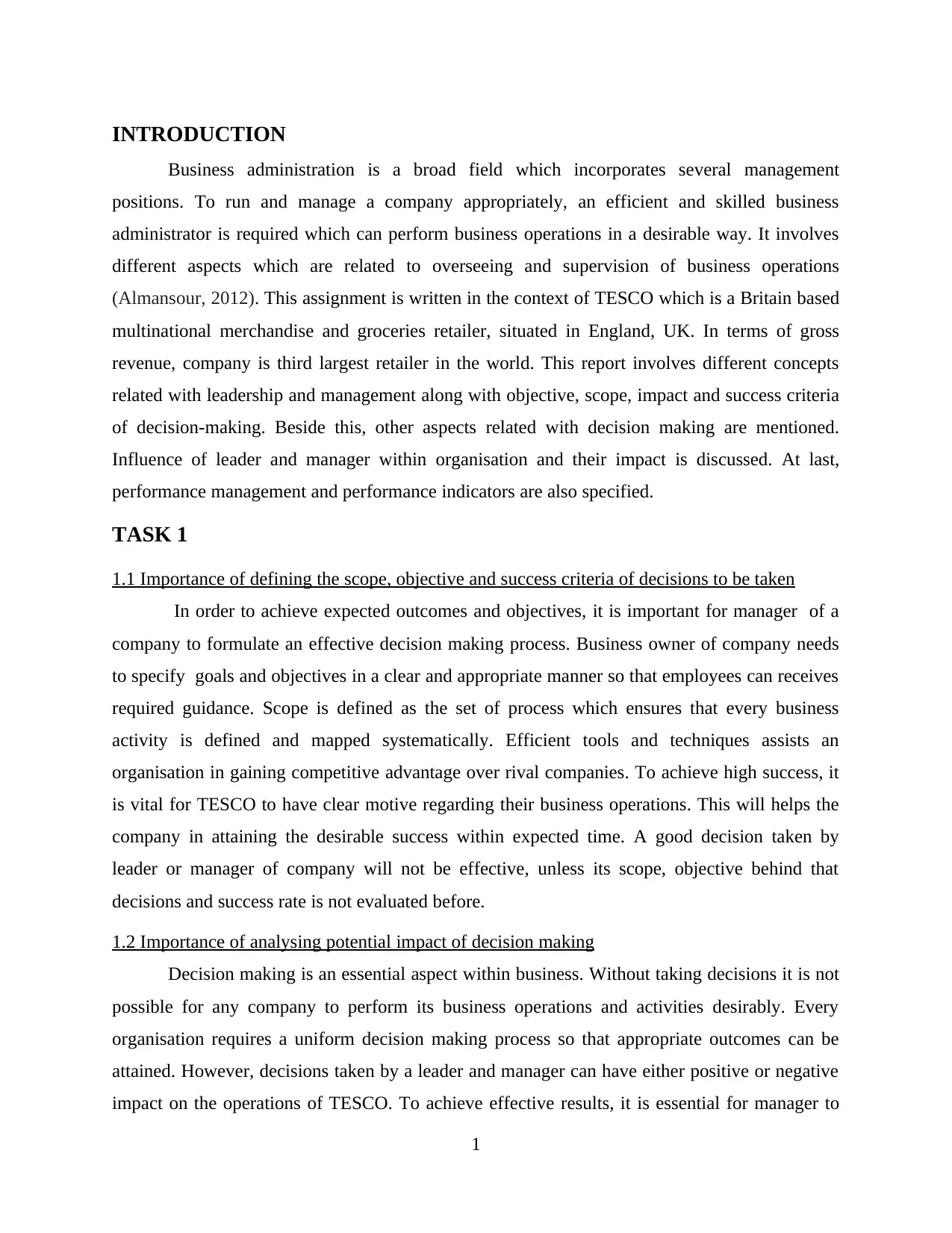
INTRODUCTION
Business administration is a broad field which incorporates several management
positions. To run and manage a company appropriately, an efficient and skilled business
administrator is required which can perform business operations in a desirable way. It involves
different aspects which are related to overseeing and supervision of business operations
(Almansour, 2012). This assignment is written in the context of TESCO which is a Britain based
multinational merchandise and groceries retailer, situated in England, UK. In terms of gross
revenue, company is third largest retailer in the world. This report involves different concepts
related with leadership and management along with objective, scope, impact and success criteria
of decision-making. Beside this, other aspects related with decision making are mentioned.
Influence of leader and manager within organisation and their impact is discussed. At last,
performance management and performance indicators are also specified.
TASK 1
1.1 Importance of defining the scope, objective and success criteria of decisions to be taken
In order to achieve expected outcomes and objectives, it is important for manager of a
company to formulate an effective decision making process. Business owner of company needs
to specify goals and objectives in a clear and appropriate manner so that employees can receives
required guidance. Scope is defined as the set of process which ensures that every business
activity is defined and mapped systematically. Efficient tools and techniques assists an
organisation in gaining competitive advantage over rival companies. To achieve high success, it
is vital for TESCO to have clear motive regarding their business operations. This will helps the
company in attaining the desirable success within expected time. A good decision taken by
leader or manager of company will not be effective, unless its scope, objective behind that
decisions and success rate is not evaluated before.
1.2 Importance of analysing potential impact of decision making
Decision making is an essential aspect within business. Without taking decisions it is not
possible for any company to perform its business operations and activities desirably. Every
organisation requires a uniform decision making process so that appropriate outcomes can be
attained. However, decisions taken by a leader and manager can have either positive or negative
impact on the operations of TESCO. To achieve effective results, it is essential for manager to
1
Business administration is a broad field which incorporates several management
positions. To run and manage a company appropriately, an efficient and skilled business
administrator is required which can perform business operations in a desirable way. It involves
different aspects which are related to overseeing and supervision of business operations
(Almansour, 2012). This assignment is written in the context of TESCO which is a Britain based
multinational merchandise and groceries retailer, situated in England, UK. In terms of gross
revenue, company is third largest retailer in the world. This report involves different concepts
related with leadership and management along with objective, scope, impact and success criteria
of decision-making. Beside this, other aspects related with decision making are mentioned.
Influence of leader and manager within organisation and their impact is discussed. At last,
performance management and performance indicators are also specified.
TASK 1
1.1 Importance of defining the scope, objective and success criteria of decisions to be taken
In order to achieve expected outcomes and objectives, it is important for manager of a
company to formulate an effective decision making process. Business owner of company needs
to specify goals and objectives in a clear and appropriate manner so that employees can receives
required guidance. Scope is defined as the set of process which ensures that every business
activity is defined and mapped systematically. Efficient tools and techniques assists an
organisation in gaining competitive advantage over rival companies. To achieve high success, it
is vital for TESCO to have clear motive regarding their business operations. This will helps the
company in attaining the desirable success within expected time. A good decision taken by
leader or manager of company will not be effective, unless its scope, objective behind that
decisions and success rate is not evaluated before.
1.2 Importance of analysing potential impact of decision making
Decision making is an essential aspect within business. Without taking decisions it is not
possible for any company to perform its business operations and activities desirably. Every
organisation requires a uniform decision making process so that appropriate outcomes can be
attained. However, decisions taken by a leader and manager can have either positive or negative
impact on the operations of TESCO. To achieve effective results, it is essential for manager to
1
Paraphrase This Document
Need a fresh take? Get an instant paraphrase of this document with our AI Paraphraser
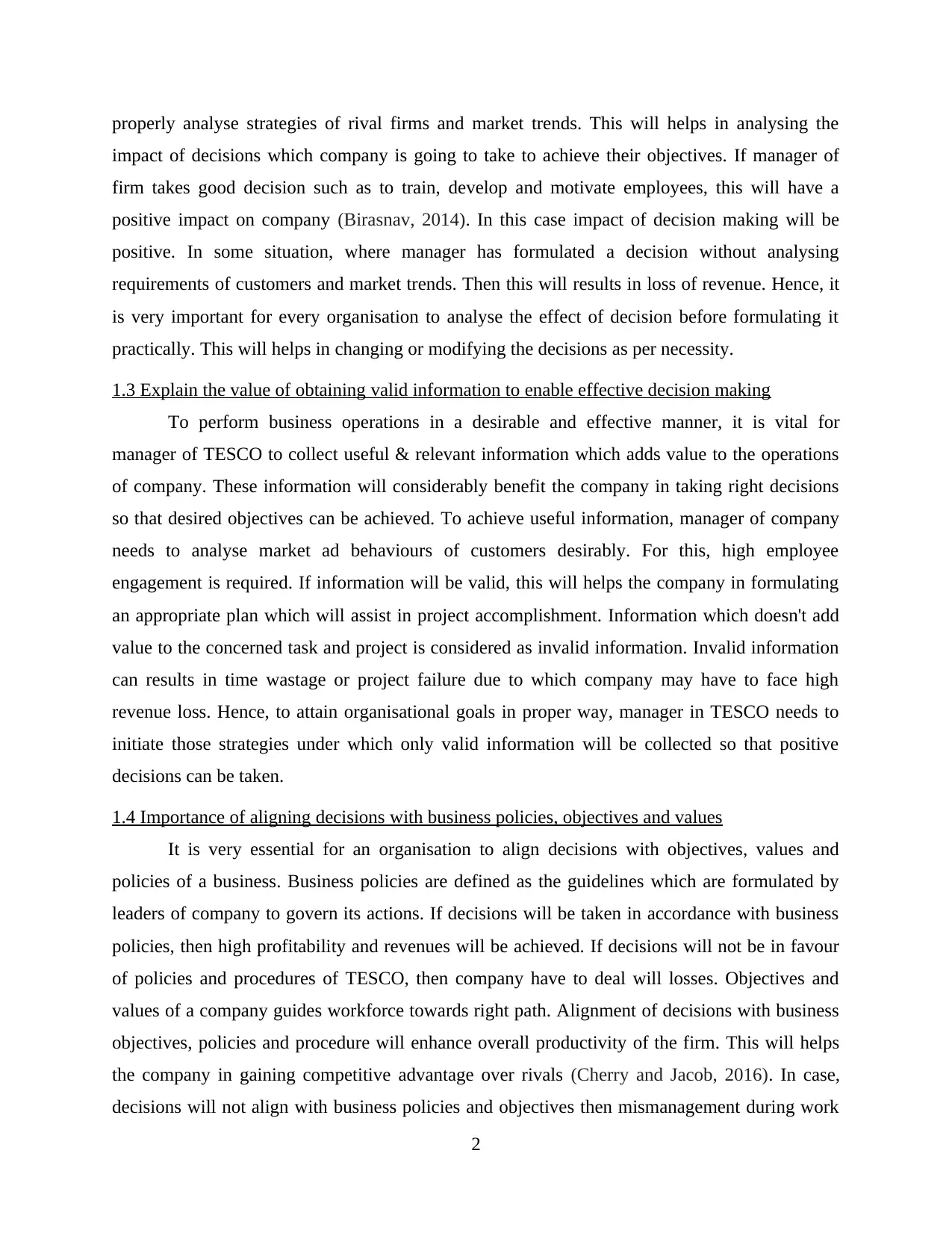
properly analyse strategies of rival firms and market trends. This will helps in analysing the
impact of decisions which company is going to take to achieve their objectives. If manager of
firm takes good decision such as to train, develop and motivate employees, this will have a
positive impact on company (Birasnav, 2014). In this case impact of decision making will be
positive. In some situation, where manager has formulated a decision without analysing
requirements of customers and market trends. Then this will results in loss of revenue. Hence, it
is very important for every organisation to analyse the effect of decision before formulating it
practically. This will helps in changing or modifying the decisions as per necessity.
1.3 Explain the value of obtaining valid information to enable effective decision making
To perform business operations in a desirable and effective manner, it is vital for
manager of TESCO to collect useful & relevant information which adds value to the operations
of company. These information will considerably benefit the company in taking right decisions
so that desired objectives can be achieved. To achieve useful information, manager of company
needs to analyse market ad behaviours of customers desirably. For this, high employee
engagement is required. If information will be valid, this will helps the company in formulating
an appropriate plan which will assist in project accomplishment. Information which doesn't add
value to the concerned task and project is considered as invalid information. Invalid information
can results in time wastage or project failure due to which company may have to face high
revenue loss. Hence, to attain organisational goals in proper way, manager in TESCO needs to
initiate those strategies under which only valid information will be collected so that positive
decisions can be taken.
1.4 Importance of aligning decisions with business policies, objectives and values
It is very essential for an organisation to align decisions with objectives, values and
policies of a business. Business policies are defined as the guidelines which are formulated by
leaders of company to govern its actions. If decisions will be taken in accordance with business
policies, then high profitability and revenues will be achieved. If decisions will not be in favour
of policies and procedures of TESCO, then company have to deal will losses. Objectives and
values of a company guides workforce towards right path. Alignment of decisions with business
objectives, policies and procedure will enhance overall productivity of the firm. This will helps
the company in gaining competitive advantage over rivals (Cherry and Jacob, 2016). In case,
decisions will not align with business policies and objectives then mismanagement during work
2
impact of decisions which company is going to take to achieve their objectives. If manager of
firm takes good decision such as to train, develop and motivate employees, this will have a
positive impact on company (Birasnav, 2014). In this case impact of decision making will be
positive. In some situation, where manager has formulated a decision without analysing
requirements of customers and market trends. Then this will results in loss of revenue. Hence, it
is very important for every organisation to analyse the effect of decision before formulating it
practically. This will helps in changing or modifying the decisions as per necessity.
1.3 Explain the value of obtaining valid information to enable effective decision making
To perform business operations in a desirable and effective manner, it is vital for
manager of TESCO to collect useful & relevant information which adds value to the operations
of company. These information will considerably benefit the company in taking right decisions
so that desired objectives can be achieved. To achieve useful information, manager of company
needs to analyse market ad behaviours of customers desirably. For this, high employee
engagement is required. If information will be valid, this will helps the company in formulating
an appropriate plan which will assist in project accomplishment. Information which doesn't add
value to the concerned task and project is considered as invalid information. Invalid information
can results in time wastage or project failure due to which company may have to face high
revenue loss. Hence, to attain organisational goals in proper way, manager in TESCO needs to
initiate those strategies under which only valid information will be collected so that positive
decisions can be taken.
1.4 Importance of aligning decisions with business policies, objectives and values
It is very essential for an organisation to align decisions with objectives, values and
policies of a business. Business policies are defined as the guidelines which are formulated by
leaders of company to govern its actions. If decisions will be taken in accordance with business
policies, then high profitability and revenues will be achieved. If decisions will not be in favour
of policies and procedures of TESCO, then company have to deal will losses. Objectives and
values of a company guides workforce towards right path. Alignment of decisions with business
objectives, policies and procedure will enhance overall productivity of the firm. This will helps
the company in gaining competitive advantage over rivals (Cherry and Jacob, 2016). In case,
decisions will not align with business policies and objectives then mismanagement during work
2
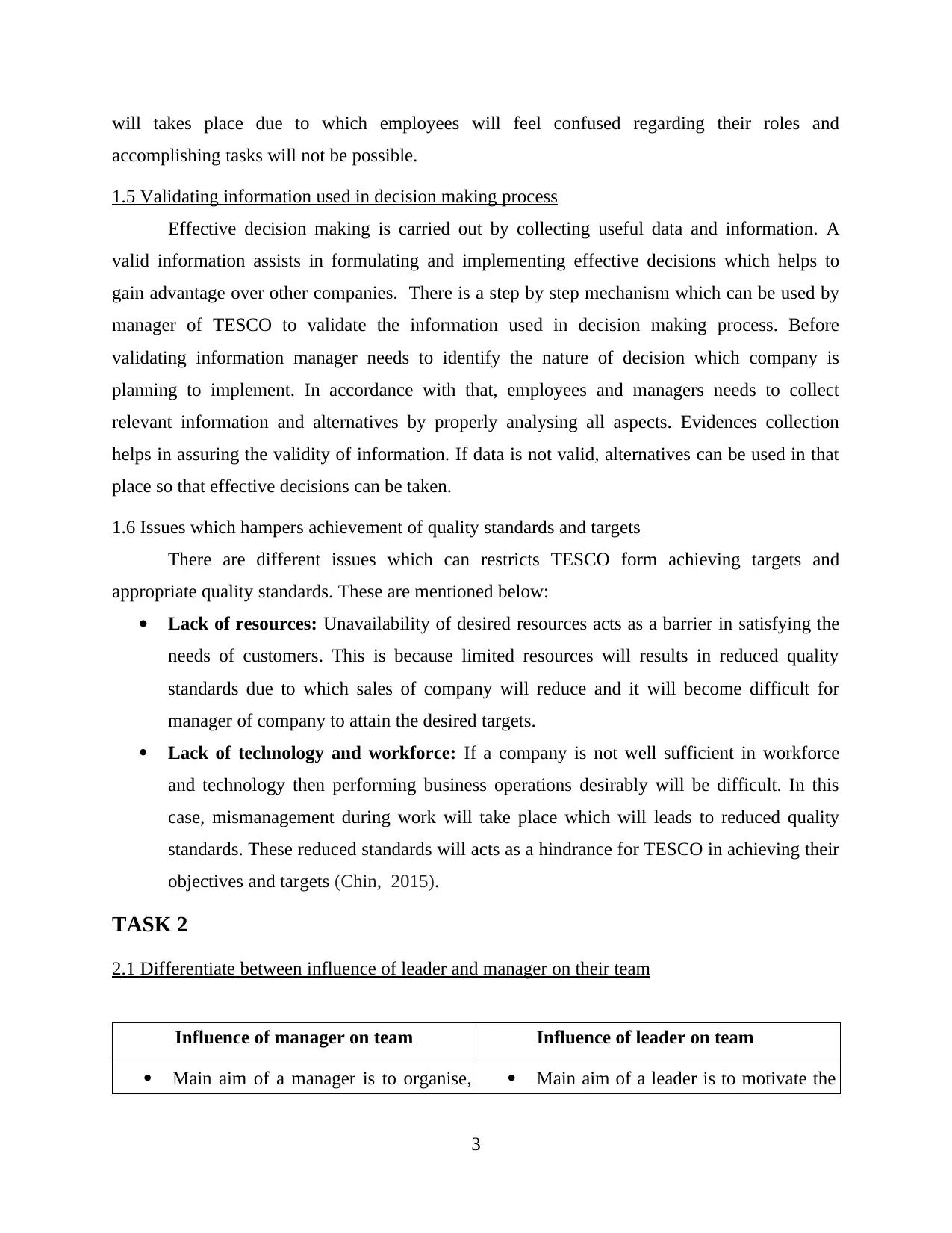
will takes place due to which employees will feel confused regarding their roles and
accomplishing tasks will not be possible.
1.5 Validating information used in decision making process
Effective decision making is carried out by collecting useful data and information. A
valid information assists in formulating and implementing effective decisions which helps to
gain advantage over other companies. There is a step by step mechanism which can be used by
manager of TESCO to validate the information used in decision making process. Before
validating information manager needs to identify the nature of decision which company is
planning to implement. In accordance with that, employees and managers needs to collect
relevant information and alternatives by properly analysing all aspects. Evidences collection
helps in assuring the validity of information. If data is not valid, alternatives can be used in that
place so that effective decisions can be taken.
1.6 Issues which hampers achievement of quality standards and targets
There are different issues which can restricts TESCO form achieving targets and
appropriate quality standards. These are mentioned below:
Lack of resources: Unavailability of desired resources acts as a barrier in satisfying the
needs of customers. This is because limited resources will results in reduced quality
standards due to which sales of company will reduce and it will become difficult for
manager of company to attain the desired targets.
Lack of technology and workforce: If a company is not well sufficient in workforce
and technology then performing business operations desirably will be difficult. In this
case, mismanagement during work will take place which will leads to reduced quality
standards. These reduced standards will acts as a hindrance for TESCO in achieving their
objectives and targets (Chin, 2015).
TASK 2
2.1 Differentiate between influence of leader and manager on their team
Influence of manager on team Influence of leader on team
Main aim of a manager is to organise, Main aim of a leader is to motivate the
3
accomplishing tasks will not be possible.
1.5 Validating information used in decision making process
Effective decision making is carried out by collecting useful data and information. A
valid information assists in formulating and implementing effective decisions which helps to
gain advantage over other companies. There is a step by step mechanism which can be used by
manager of TESCO to validate the information used in decision making process. Before
validating information manager needs to identify the nature of decision which company is
planning to implement. In accordance with that, employees and managers needs to collect
relevant information and alternatives by properly analysing all aspects. Evidences collection
helps in assuring the validity of information. If data is not valid, alternatives can be used in that
place so that effective decisions can be taken.
1.6 Issues which hampers achievement of quality standards and targets
There are different issues which can restricts TESCO form achieving targets and
appropriate quality standards. These are mentioned below:
Lack of resources: Unavailability of desired resources acts as a barrier in satisfying the
needs of customers. This is because limited resources will results in reduced quality
standards due to which sales of company will reduce and it will become difficult for
manager of company to attain the desired targets.
Lack of technology and workforce: If a company is not well sufficient in workforce
and technology then performing business operations desirably will be difficult. In this
case, mismanagement during work will take place which will leads to reduced quality
standards. These reduced standards will acts as a hindrance for TESCO in achieving their
objectives and targets (Chin, 2015).
TASK 2
2.1 Differentiate between influence of leader and manager on their team
Influence of manager on team Influence of leader on team
Main aim of a manager is to organise, Main aim of a leader is to motivate the
3
⊘ This is a preview!⊘
Do you want full access?
Subscribe today to unlock all pages.

Trusted by 1+ million students worldwide
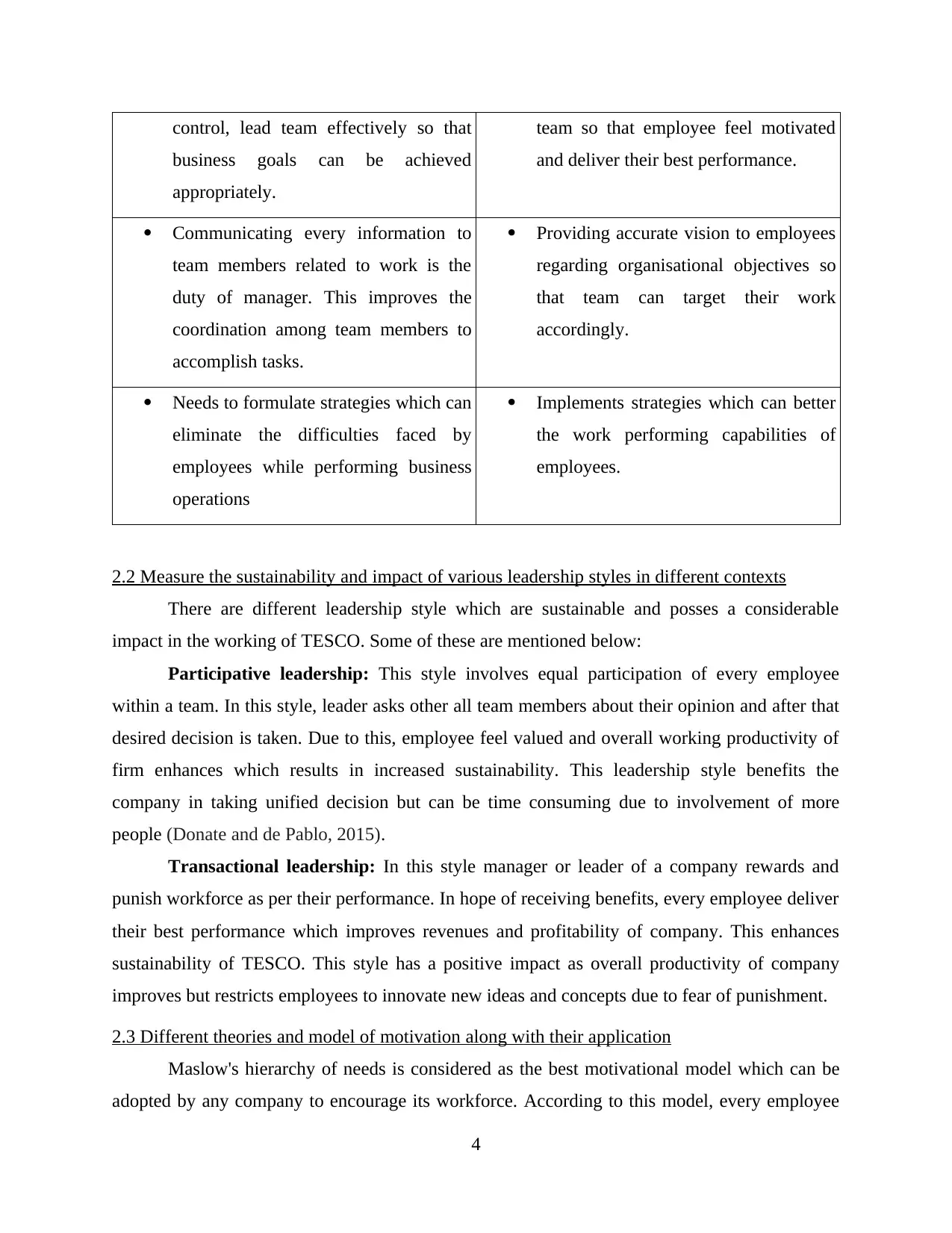
control, lead team effectively so that
business goals can be achieved
appropriately.
team so that employee feel motivated
and deliver their best performance.
Communicating every information to
team members related to work is the
duty of manager. This improves the
coordination among team members to
accomplish tasks.
Providing accurate vision to employees
regarding organisational objectives so
that team can target their work
accordingly.
Needs to formulate strategies which can
eliminate the difficulties faced by
employees while performing business
operations
Implements strategies which can better
the work performing capabilities of
employees.
2.2 Measure the sustainability and impact of various leadership styles in different contexts
There are different leadership style which are sustainable and posses a considerable
impact in the working of TESCO. Some of these are mentioned below:
Participative leadership: This style involves equal participation of every employee
within a team. In this style, leader asks other all team members about their opinion and after that
desired decision is taken. Due to this, employee feel valued and overall working productivity of
firm enhances which results in increased sustainability. This leadership style benefits the
company in taking unified decision but can be time consuming due to involvement of more
people (Donate and de Pablo, 2015).
Transactional leadership: In this style manager or leader of a company rewards and
punish workforce as per their performance. In hope of receiving benefits, every employee deliver
their best performance which improves revenues and profitability of company. This enhances
sustainability of TESCO. This style has a positive impact as overall productivity of company
improves but restricts employees to innovate new ideas and concepts due to fear of punishment.
2.3 Different theories and model of motivation along with their application
Maslow's hierarchy of needs is considered as the best motivational model which can be
adopted by any company to encourage its workforce. According to this model, every employee
4
business goals can be achieved
appropriately.
team so that employee feel motivated
and deliver their best performance.
Communicating every information to
team members related to work is the
duty of manager. This improves the
coordination among team members to
accomplish tasks.
Providing accurate vision to employees
regarding organisational objectives so
that team can target their work
accordingly.
Needs to formulate strategies which can
eliminate the difficulties faced by
employees while performing business
operations
Implements strategies which can better
the work performing capabilities of
employees.
2.2 Measure the sustainability and impact of various leadership styles in different contexts
There are different leadership style which are sustainable and posses a considerable
impact in the working of TESCO. Some of these are mentioned below:
Participative leadership: This style involves equal participation of every employee
within a team. In this style, leader asks other all team members about their opinion and after that
desired decision is taken. Due to this, employee feel valued and overall working productivity of
firm enhances which results in increased sustainability. This leadership style benefits the
company in taking unified decision but can be time consuming due to involvement of more
people (Donate and de Pablo, 2015).
Transactional leadership: In this style manager or leader of a company rewards and
punish workforce as per their performance. In hope of receiving benefits, every employee deliver
their best performance which improves revenues and profitability of company. This enhances
sustainability of TESCO. This style has a positive impact as overall productivity of company
improves but restricts employees to innovate new ideas and concepts due to fear of punishment.
2.3 Different theories and model of motivation along with their application
Maslow's hierarchy of needs is considered as the best motivational model which can be
adopted by any company to encourage its workforce. According to this model, every employee
4
Paraphrase This Document
Need a fresh take? Get an instant paraphrase of this document with our AI Paraphraser
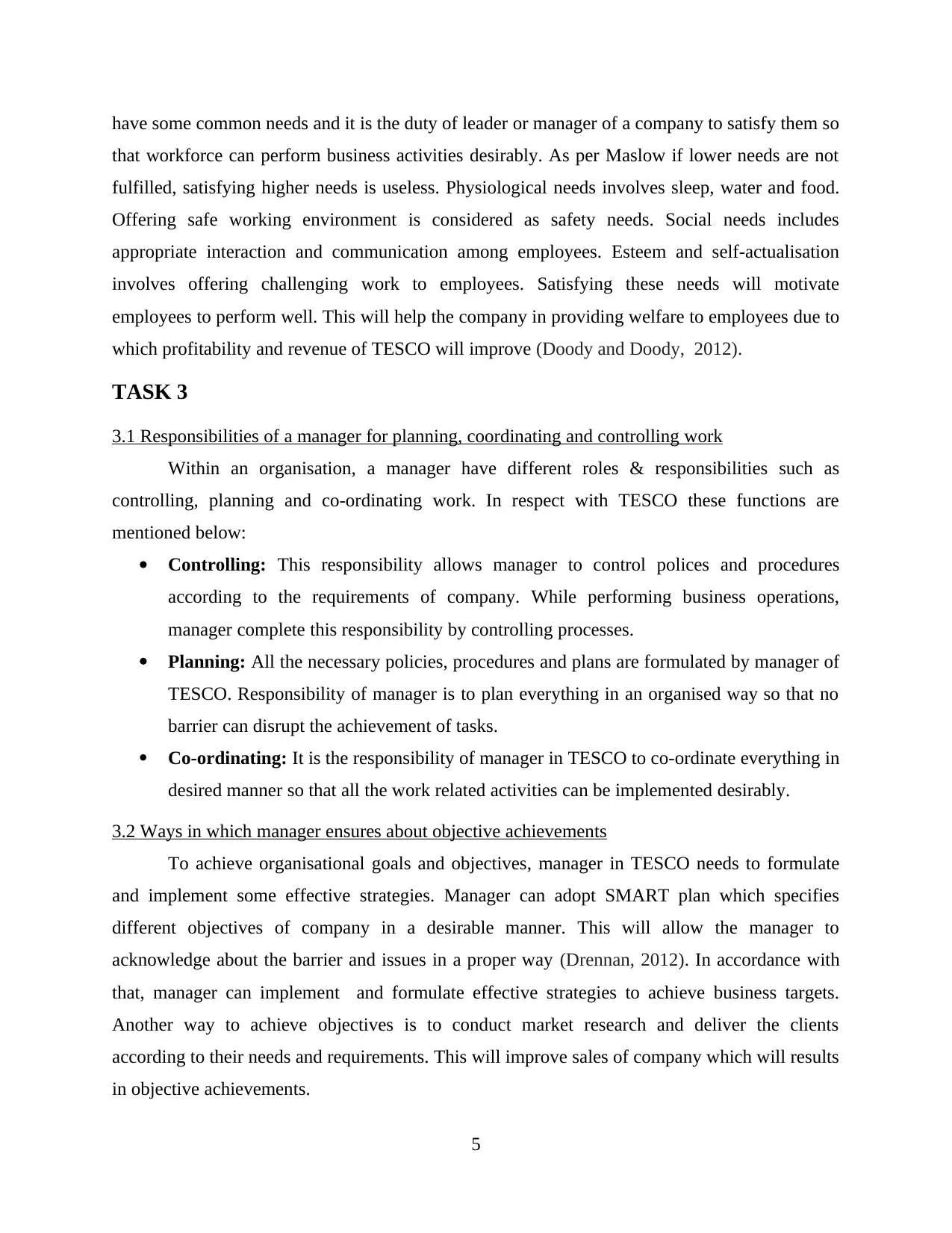
have some common needs and it is the duty of leader or manager of a company to satisfy them so
that workforce can perform business activities desirably. As per Maslow if lower needs are not
fulfilled, satisfying higher needs is useless. Physiological needs involves sleep, water and food.
Offering safe working environment is considered as safety needs. Social needs includes
appropriate interaction and communication among employees. Esteem and self-actualisation
involves offering challenging work to employees. Satisfying these needs will motivate
employees to perform well. This will help the company in providing welfare to employees due to
which profitability and revenue of TESCO will improve (Doody and Doody, 2012).
TASK 3
3.1 Responsibilities of a manager for planning, coordinating and controlling work
Within an organisation, a manager have different roles & responsibilities such as
controlling, planning and co-ordinating work. In respect with TESCO these functions are
mentioned below:
Controlling: This responsibility allows manager to control polices and procedures
according to the requirements of company. While performing business operations,
manager complete this responsibility by controlling processes.
Planning: All the necessary policies, procedures and plans are formulated by manager of
TESCO. Responsibility of manager is to plan everything in an organised way so that no
barrier can disrupt the achievement of tasks.
Co-ordinating: It is the responsibility of manager in TESCO to co-ordinate everything in
desired manner so that all the work related activities can be implemented desirably.
3.2 Ways in which manager ensures about objective achievements
To achieve organisational goals and objectives, manager in TESCO needs to formulate
and implement some effective strategies. Manager can adopt SMART plan which specifies
different objectives of company in a desirable manner. This will allow the manager to
acknowledge about the barrier and issues in a proper way (Drennan, 2012). In accordance with
that, manager can implement and formulate effective strategies to achieve business targets.
Another way to achieve objectives is to conduct market research and deliver the clients
according to their needs and requirements. This will improve sales of company which will results
in objective achievements.
5
that workforce can perform business activities desirably. As per Maslow if lower needs are not
fulfilled, satisfying higher needs is useless. Physiological needs involves sleep, water and food.
Offering safe working environment is considered as safety needs. Social needs includes
appropriate interaction and communication among employees. Esteem and self-actualisation
involves offering challenging work to employees. Satisfying these needs will motivate
employees to perform well. This will help the company in providing welfare to employees due to
which profitability and revenue of TESCO will improve (Doody and Doody, 2012).
TASK 3
3.1 Responsibilities of a manager for planning, coordinating and controlling work
Within an organisation, a manager have different roles & responsibilities such as
controlling, planning and co-ordinating work. In respect with TESCO these functions are
mentioned below:
Controlling: This responsibility allows manager to control polices and procedures
according to the requirements of company. While performing business operations,
manager complete this responsibility by controlling processes.
Planning: All the necessary policies, procedures and plans are formulated by manager of
TESCO. Responsibility of manager is to plan everything in an organised way so that no
barrier can disrupt the achievement of tasks.
Co-ordinating: It is the responsibility of manager in TESCO to co-ordinate everything in
desired manner so that all the work related activities can be implemented desirably.
3.2 Ways in which manager ensures about objective achievements
To achieve organisational goals and objectives, manager in TESCO needs to formulate
and implement some effective strategies. Manager can adopt SMART plan which specifies
different objectives of company in a desirable manner. This will allow the manager to
acknowledge about the barrier and issues in a proper way (Drennan, 2012). In accordance with
that, manager can implement and formulate effective strategies to achieve business targets.
Another way to achieve objectives is to conduct market research and deliver the clients
according to their needs and requirements. This will improve sales of company which will results
in objective achievements.
5
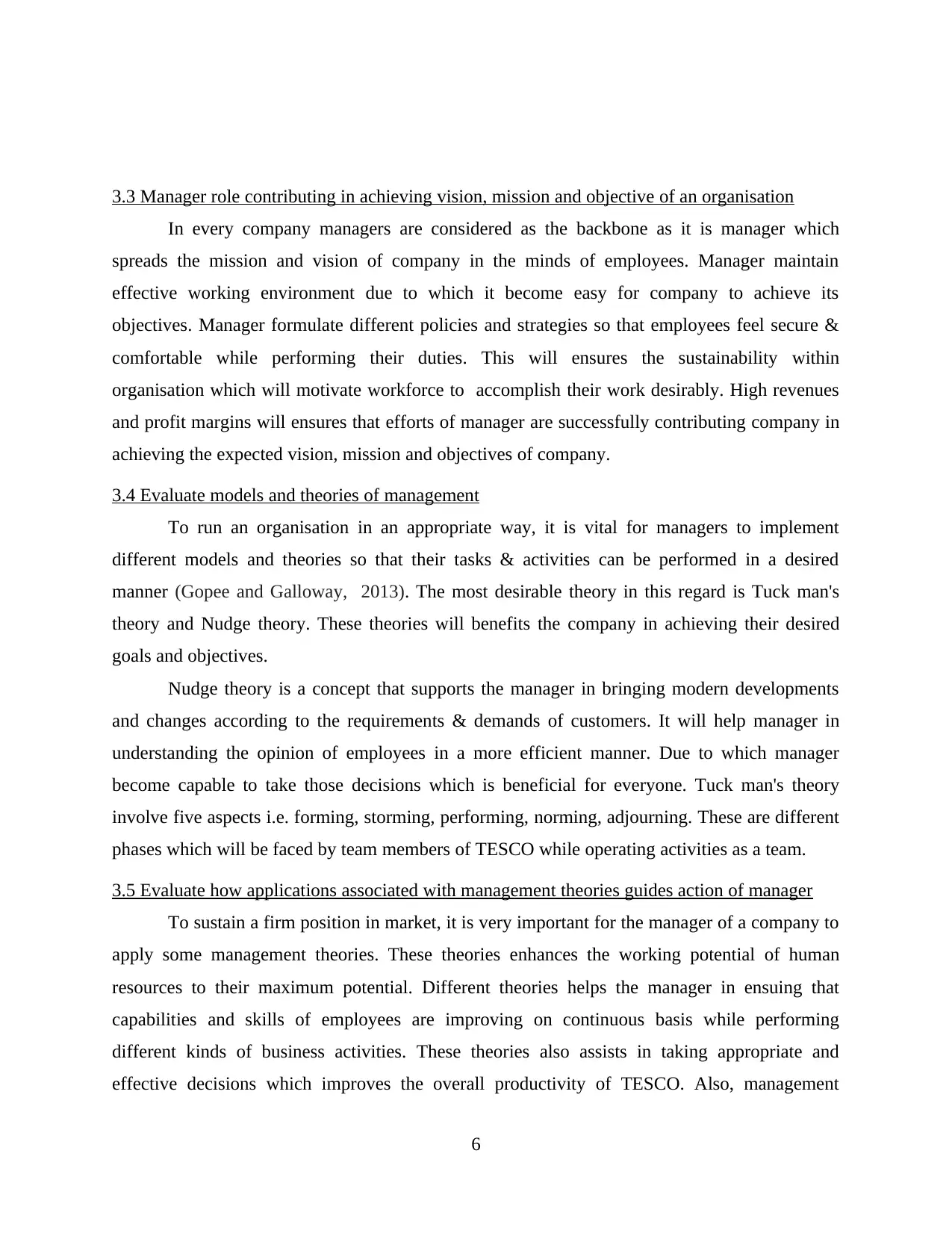
3.3 Manager role contributing in achieving vision, mission and objective of an organisation
In every company managers are considered as the backbone as it is manager which
spreads the mission and vision of company in the minds of employees. Manager maintain
effective working environment due to which it become easy for company to achieve its
objectives. Manager formulate different policies and strategies so that employees feel secure &
comfortable while performing their duties. This will ensures the sustainability within
organisation which will motivate workforce to accomplish their work desirably. High revenues
and profit margins will ensures that efforts of manager are successfully contributing company in
achieving the expected vision, mission and objectives of company.
3.4 Evaluate models and theories of management
To run an organisation in an appropriate way, it is vital for managers to implement
different models and theories so that their tasks & activities can be performed in a desired
manner (Gopee and Galloway, 2013). The most desirable theory in this regard is Tuck man's
theory and Nudge theory. These theories will benefits the company in achieving their desired
goals and objectives.
Nudge theory is a concept that supports the manager in bringing modern developments
and changes according to the requirements & demands of customers. It will help manager in
understanding the opinion of employees in a more efficient manner. Due to which manager
become capable to take those decisions which is beneficial for everyone. Tuck man's theory
involve five aspects i.e. forming, storming, performing, norming, adjourning. These are different
phases which will be faced by team members of TESCO while operating activities as a team.
3.5 Evaluate how applications associated with management theories guides action of manager
To sustain a firm position in market, it is very important for the manager of a company to
apply some management theories. These theories enhances the working potential of human
resources to their maximum potential. Different theories helps the manager in ensuing that
capabilities and skills of employees are improving on continuous basis while performing
different kinds of business activities. These theories also assists in taking appropriate and
effective decisions which improves the overall productivity of TESCO. Also, management
6
In every company managers are considered as the backbone as it is manager which
spreads the mission and vision of company in the minds of employees. Manager maintain
effective working environment due to which it become easy for company to achieve its
objectives. Manager formulate different policies and strategies so that employees feel secure &
comfortable while performing their duties. This will ensures the sustainability within
organisation which will motivate workforce to accomplish their work desirably. High revenues
and profit margins will ensures that efforts of manager are successfully contributing company in
achieving the expected vision, mission and objectives of company.
3.4 Evaluate models and theories of management
To run an organisation in an appropriate way, it is vital for managers to implement
different models and theories so that their tasks & activities can be performed in a desired
manner (Gopee and Galloway, 2013). The most desirable theory in this regard is Tuck man's
theory and Nudge theory. These theories will benefits the company in achieving their desired
goals and objectives.
Nudge theory is a concept that supports the manager in bringing modern developments
and changes according to the requirements & demands of customers. It will help manager in
understanding the opinion of employees in a more efficient manner. Due to which manager
become capable to take those decisions which is beneficial for everyone. Tuck man's theory
involve five aspects i.e. forming, storming, performing, norming, adjourning. These are different
phases which will be faced by team members of TESCO while operating activities as a team.
3.5 Evaluate how applications associated with management theories guides action of manager
To sustain a firm position in market, it is very important for the manager of a company to
apply some management theories. These theories enhances the working potential of human
resources to their maximum potential. Different theories helps the manager in ensuing that
capabilities and skills of employees are improving on continuous basis while performing
different kinds of business activities. These theories also assists in taking appropriate and
effective decisions which improves the overall productivity of TESCO. Also, management
6
⊘ This is a preview!⊘
Do you want full access?
Subscribe today to unlock all pages.

Trusted by 1+ million students worldwide
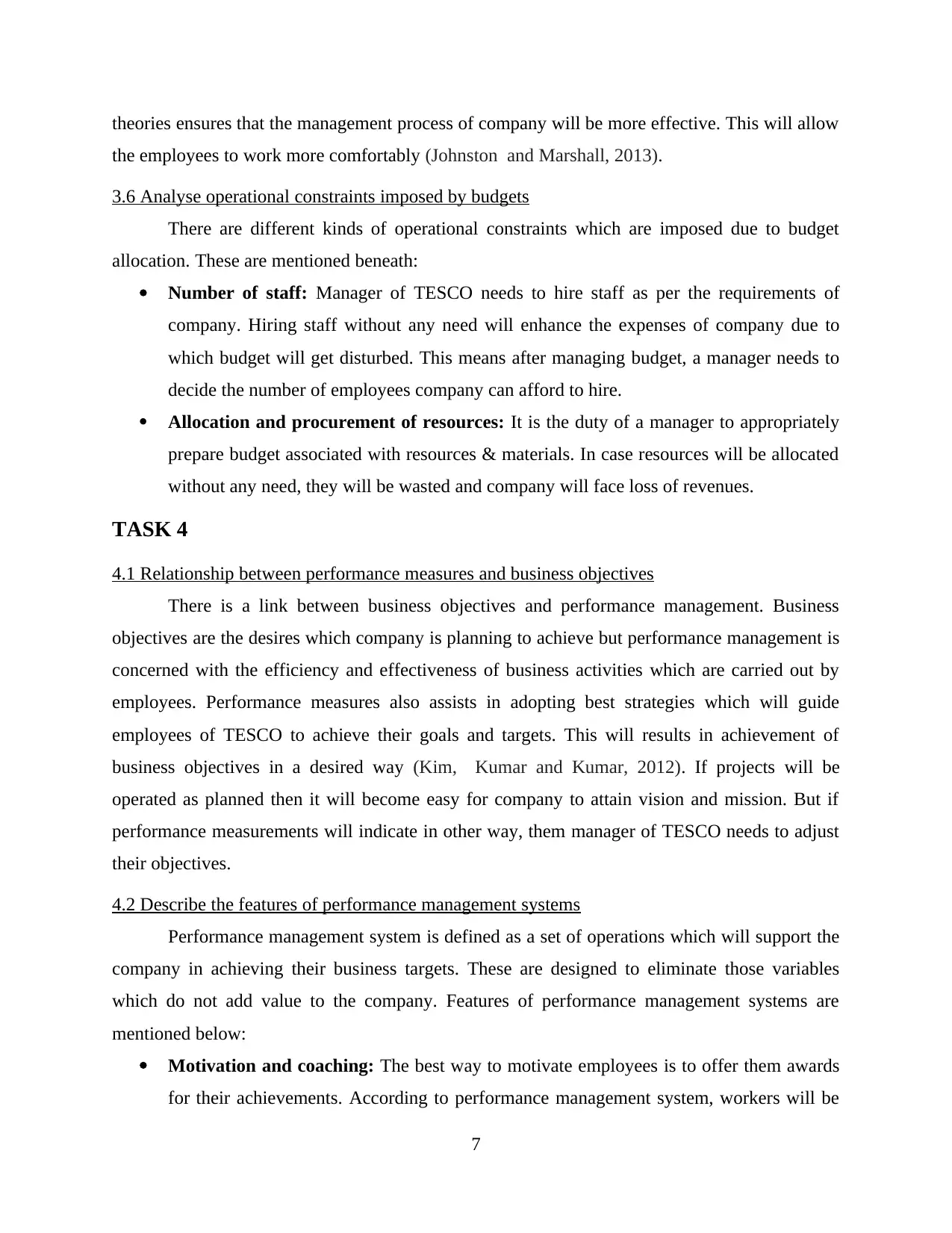
theories ensures that the management process of company will be more effective. This will allow
the employees to work more comfortably (Johnston and Marshall, 2013).
3.6 Analyse operational constraints imposed by budgets
There are different kinds of operational constraints which are imposed due to budget
allocation. These are mentioned beneath:
Number of staff: Manager of TESCO needs to hire staff as per the requirements of
company. Hiring staff without any need will enhance the expenses of company due to
which budget will get disturbed. This means after managing budget, a manager needs to
decide the number of employees company can afford to hire.
Allocation and procurement of resources: It is the duty of a manager to appropriately
prepare budget associated with resources & materials. In case resources will be allocated
without any need, they will be wasted and company will face loss of revenues.
TASK 4
4.1 Relationship between performance measures and business objectives
There is a link between business objectives and performance management. Business
objectives are the desires which company is planning to achieve but performance management is
concerned with the efficiency and effectiveness of business activities which are carried out by
employees. Performance measures also assists in adopting best strategies which will guide
employees of TESCO to achieve their goals and targets. This will results in achievement of
business objectives in a desired way (Kim, Kumar and Kumar, 2012). If projects will be
operated as planned then it will become easy for company to attain vision and mission. But if
performance measurements will indicate in other way, them manager of TESCO needs to adjust
their objectives.
4.2 Describe the features of performance management systems
Performance management system is defined as a set of operations which will support the
company in achieving their business targets. These are designed to eliminate those variables
which do not add value to the company. Features of performance management systems are
mentioned below:
Motivation and coaching: The best way to motivate employees is to offer them awards
for their achievements. According to performance management system, workers will be
7
the employees to work more comfortably (Johnston and Marshall, 2013).
3.6 Analyse operational constraints imposed by budgets
There are different kinds of operational constraints which are imposed due to budget
allocation. These are mentioned beneath:
Number of staff: Manager of TESCO needs to hire staff as per the requirements of
company. Hiring staff without any need will enhance the expenses of company due to
which budget will get disturbed. This means after managing budget, a manager needs to
decide the number of employees company can afford to hire.
Allocation and procurement of resources: It is the duty of a manager to appropriately
prepare budget associated with resources & materials. In case resources will be allocated
without any need, they will be wasted and company will face loss of revenues.
TASK 4
4.1 Relationship between performance measures and business objectives
There is a link between business objectives and performance management. Business
objectives are the desires which company is planning to achieve but performance management is
concerned with the efficiency and effectiveness of business activities which are carried out by
employees. Performance measures also assists in adopting best strategies which will guide
employees of TESCO to achieve their goals and targets. This will results in achievement of
business objectives in a desired way (Kim, Kumar and Kumar, 2012). If projects will be
operated as planned then it will become easy for company to attain vision and mission. But if
performance measurements will indicate in other way, them manager of TESCO needs to adjust
their objectives.
4.2 Describe the features of performance management systems
Performance management system is defined as a set of operations which will support the
company in achieving their business targets. These are designed to eliminate those variables
which do not add value to the company. Features of performance management systems are
mentioned below:
Motivation and coaching: The best way to motivate employees is to offer them awards
for their achievements. According to performance management system, workers will be
7
Paraphrase This Document
Need a fresh take? Get an instant paraphrase of this document with our AI Paraphraser
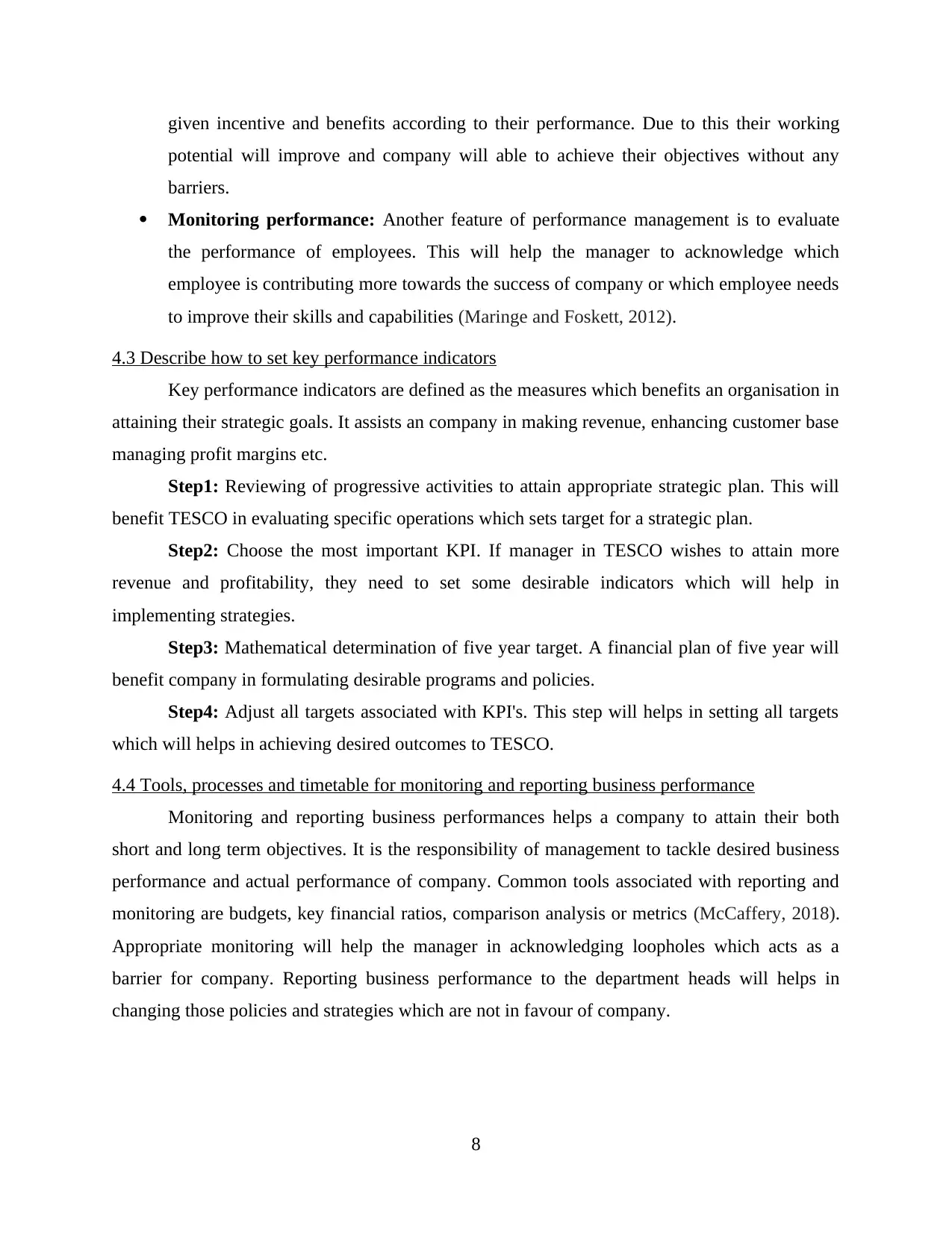
given incentive and benefits according to their performance. Due to this their working
potential will improve and company will able to achieve their objectives without any
barriers.
Monitoring performance: Another feature of performance management is to evaluate
the performance of employees. This will help the manager to acknowledge which
employee is contributing more towards the success of company or which employee needs
to improve their skills and capabilities (Maringe and Foskett, 2012).
4.3 Describe how to set key performance indicators
Key performance indicators are defined as the measures which benefits an organisation in
attaining their strategic goals. It assists an company in making revenue, enhancing customer base
managing profit margins etc.
Step1: Reviewing of progressive activities to attain appropriate strategic plan. This will
benefit TESCO in evaluating specific operations which sets target for a strategic plan.
Step2: Choose the most important KPI. If manager in TESCO wishes to attain more
revenue and profitability, they need to set some desirable indicators which will help in
implementing strategies.
Step3: Mathematical determination of five year target. A financial plan of five year will
benefit company in formulating desirable programs and policies.
Step4: Adjust all targets associated with KPI's. This step will helps in setting all targets
which will helps in achieving desired outcomes to TESCO.
4.4 Tools, processes and timetable for monitoring and reporting business performance
Monitoring and reporting business performances helps a company to attain their both
short and long term objectives. It is the responsibility of management to tackle desired business
performance and actual performance of company. Common tools associated with reporting and
monitoring are budgets, key financial ratios, comparison analysis or metrics (McCaffery, 2018).
Appropriate monitoring will help the manager in acknowledging loopholes which acts as a
barrier for company. Reporting business performance to the department heads will helps in
changing those policies and strategies which are not in favour of company.
8
potential will improve and company will able to achieve their objectives without any
barriers.
Monitoring performance: Another feature of performance management is to evaluate
the performance of employees. This will help the manager to acknowledge which
employee is contributing more towards the success of company or which employee needs
to improve their skills and capabilities (Maringe and Foskett, 2012).
4.3 Describe how to set key performance indicators
Key performance indicators are defined as the measures which benefits an organisation in
attaining their strategic goals. It assists an company in making revenue, enhancing customer base
managing profit margins etc.
Step1: Reviewing of progressive activities to attain appropriate strategic plan. This will
benefit TESCO in evaluating specific operations which sets target for a strategic plan.
Step2: Choose the most important KPI. If manager in TESCO wishes to attain more
revenue and profitability, they need to set some desirable indicators which will help in
implementing strategies.
Step3: Mathematical determination of five year target. A financial plan of five year will
benefit company in formulating desirable programs and policies.
Step4: Adjust all targets associated with KPI's. This step will helps in setting all targets
which will helps in achieving desired outcomes to TESCO.
4.4 Tools, processes and timetable for monitoring and reporting business performance
Monitoring and reporting business performances helps a company to attain their both
short and long term objectives. It is the responsibility of management to tackle desired business
performance and actual performance of company. Common tools associated with reporting and
monitoring are budgets, key financial ratios, comparison analysis or metrics (McCaffery, 2018).
Appropriate monitoring will help the manager in acknowledging loopholes which acts as a
barrier for company. Reporting business performance to the department heads will helps in
changing those policies and strategies which are not in favour of company.
8
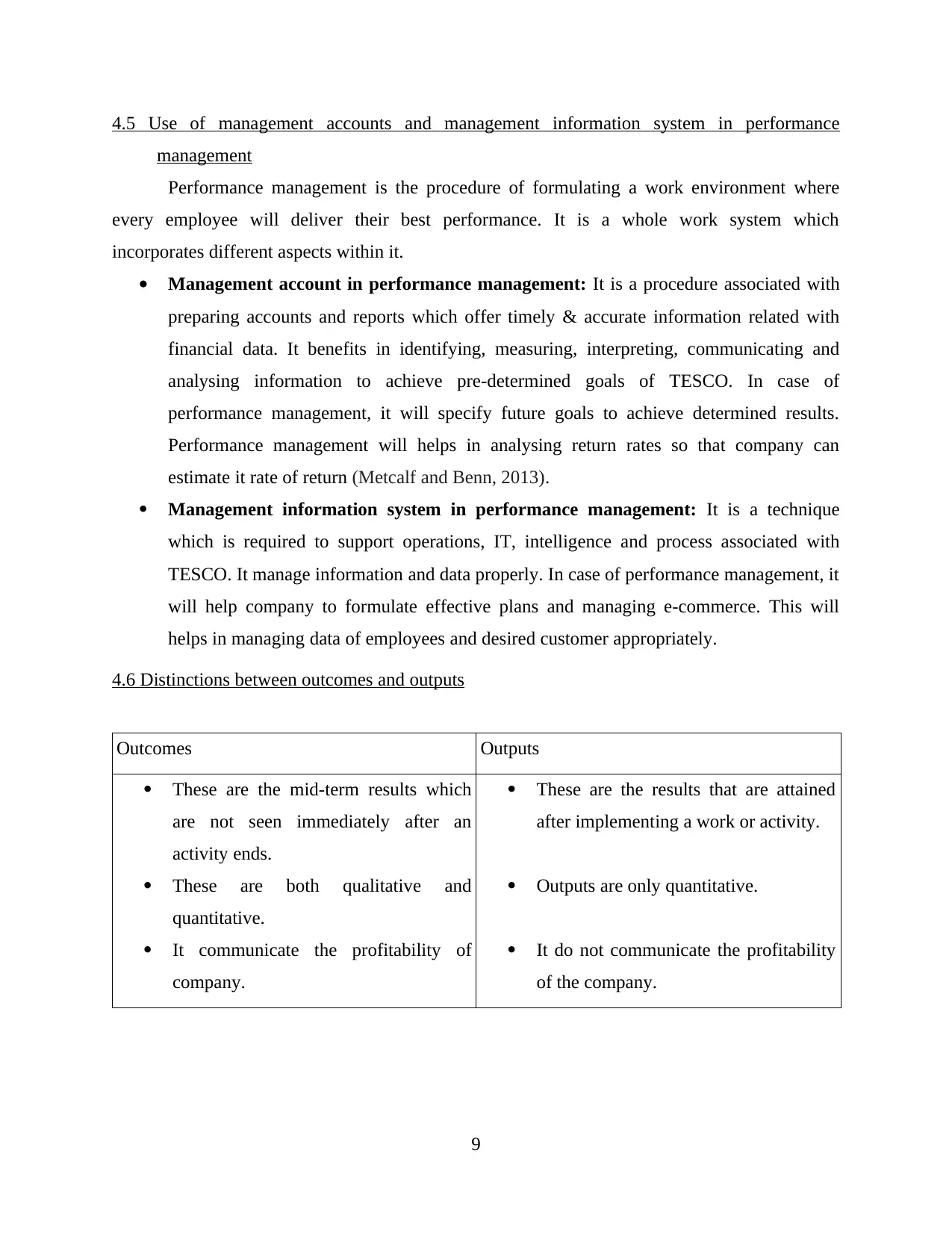
4.5 Use of management accounts and management information system in performance
management
Performance management is the procedure of formulating a work environment where
every employee will deliver their best performance. It is a whole work system which
incorporates different aspects within it.
Management account in performance management: It is a procedure associated with
preparing accounts and reports which offer timely & accurate information related with
financial data. It benefits in identifying, measuring, interpreting, communicating and
analysing information to achieve pre-determined goals of TESCO. In case of
performance management, it will specify future goals to achieve determined results.
Performance management will helps in analysing return rates so that company can
estimate it rate of return (Metcalf and Benn, 2013).
Management information system in performance management: It is a technique
which is required to support operations, IT, intelligence and process associated with
TESCO. It manage information and data properly. In case of performance management, it
will help company to formulate effective plans and managing e-commerce. This will
helps in managing data of employees and desired customer appropriately.
4.6 Distinctions between outcomes and outputs
Outcomes Outputs
These are the mid-term results which
are not seen immediately after an
activity ends.
These are both qualitative and
quantitative.
It communicate the profitability of
company.
These are the results that are attained
after implementing a work or activity.
Outputs are only quantitative.
It do not communicate the profitability
of the company.
9
management
Performance management is the procedure of formulating a work environment where
every employee will deliver their best performance. It is a whole work system which
incorporates different aspects within it.
Management account in performance management: It is a procedure associated with
preparing accounts and reports which offer timely & accurate information related with
financial data. It benefits in identifying, measuring, interpreting, communicating and
analysing information to achieve pre-determined goals of TESCO. In case of
performance management, it will specify future goals to achieve determined results.
Performance management will helps in analysing return rates so that company can
estimate it rate of return (Metcalf and Benn, 2013).
Management information system in performance management: It is a technique
which is required to support operations, IT, intelligence and process associated with
TESCO. It manage information and data properly. In case of performance management, it
will help company to formulate effective plans and managing e-commerce. This will
helps in managing data of employees and desired customer appropriately.
4.6 Distinctions between outcomes and outputs
Outcomes Outputs
These are the mid-term results which
are not seen immediately after an
activity ends.
These are both qualitative and
quantitative.
It communicate the profitability of
company.
These are the results that are attained
after implementing a work or activity.
Outputs are only quantitative.
It do not communicate the profitability
of the company.
9
⊘ This is a preview!⊘
Do you want full access?
Subscribe today to unlock all pages.

Trusted by 1+ million students worldwide
1 out of 15
Related Documents
Your All-in-One AI-Powered Toolkit for Academic Success.
+13062052269
info@desklib.com
Available 24*7 on WhatsApp / Email
![[object Object]](/_next/static/media/star-bottom.7253800d.svg)
Unlock your academic potential
Copyright © 2020–2025 A2Z Services. All Rights Reserved. Developed and managed by ZUCOL.





